-
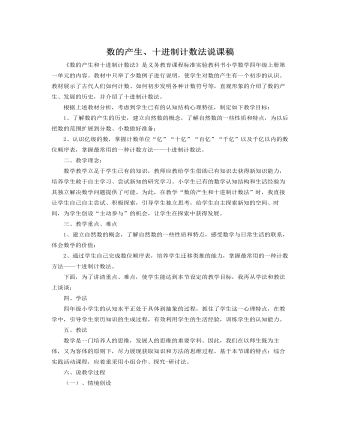
人教版新课标小学数学四年级上册数的产生、十进制计数法说课稿
2、十进制计数法(1)、师提问:“同学们,我们在前几节课已经学习了到万级为止的数,但是,还有比亿更大的数存在着,(出示数位顺序表):引导学生利用已有的知识进行类推,将已学过的亿以内数位顺序表扩展到“千亿”。教师在计数器上现场贴上亿级的数位。(教师向学生说明:还有比千亿更大的数,由于不常用,暂时不学,因此在数为顺序表后面用“…”,表示后面还有其他数位。)(2)、教师提问:“那么,我们已经学习了哪些计数单位呢?”(3)、小组讨论:“每相邻的两个计数单位之间的进率是多少?”请同学们自己得出结论:每相邻的两个计数单位之间的进率都是十。最后,教师给出“十进制计数法”的名称,在黑板上板书。(三)、课堂总结1、教师:“同学们,今天我们一起学习了?”教师请同学们接下去说完整:“自然数和十进制计数法。”

新人教版高中英语选修2Unit 4 Journey Across a Vast Land教学设计
当孩子们由父母陪同时,他们才被允许进入这个运动场。3.过去分词(短语)作状语时的几种特殊情况(1)过去分词(短语)在句中作时间、条件、原因、让步状语时,相当于对应的时间、条件、原因及让步状语从句。Seen from the top of the mountain (=When it is seen from the top of the mountain), the whole town looks more beautiful.从山顶上看,整个城市看起来更美了。Given ten more minutes (=If we are given ten more minutes), we will finish the work perfectly.如果多给十分钟,我们会完美地完成这项工作。Greatly touched by his words (=Because she was greatly touched by his words), she was full of tears.由于被他的话深深地感动,她满眼泪花。Warned of the storm (=Though they were warned of the storm), the farmers were still working on the farm.尽管被警告了风暴的到来,但农民们仍在农场干活。(2)过去分词(短语)在句中作伴随、方式等状语时,可改为句子的并列谓语或改为并列分句。The teacher came into the room, followed by two students (=and was followed by two students).后面跟着两个学生,老师走进了房间。He spent the whole afternoon, accompanied by his mom(=and was accompanied by his mom).他由母亲陪着度过了一整个下午。
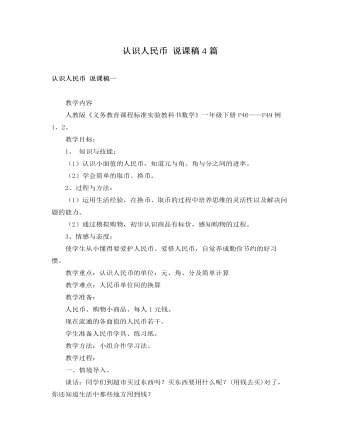
人教版新课标小学数学一年级下册认识人民币 说课稿4篇
一、说教材《认识人民币》是人教版小学数学一年级下册第五单元的第一课时的内容。本课是让学生认识各种面值的人民币,初步知道人民币的基本知识和如何使用人民币,提高社会实践能力;另一方面使学生加深对100以内数的概念的理解,体会数概念与现实生活的密切联系。二、说教学目标1、学生能够正确的认识各种面值的人民币,知道人民币的单位元、角、分,知道1元=10角。 2、能较熟练地辨认各种面值的人民币。 3、感受数学与实际生活的密切联系。。教学重点:认识各种面值的人民币,知道人民币的单位元、角、分,知道1元=10角。教学难点:人民币的等价兑换。三、说教法、学法在整个教学过程中采用小组合作交流的学习方式,为学生设计猜一猜,看钱、认钱,唱歌、分类等活动。
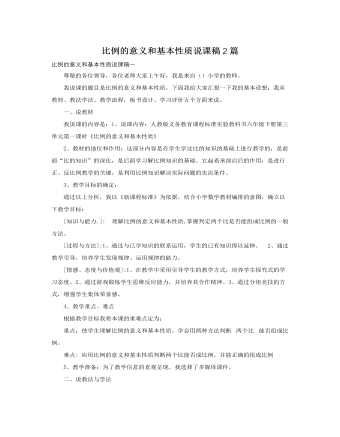
人教版新课标小学数学六年级下册比例的意义和基本性质说课稿2篇
4.教学比例的各部分名称这部分的教学,我采用了阅读自学法。实施素质教育,使学生由“学会”变“会学”,这里我注重培养学生的自学能力,师生的双边关系亦实现从扶到放的转变。在学生自学课本时,老师写出比例的两种形式,引导学生注意内项和外项的位置。5.教学比例的基本性质观察80:2=200:5中的两个内项的积与两个外项的积的关系,引导学生把两个外项与两个内项分别相乘,比较结果,然后引导他们回答:2:3 = 0.4:0.6。两个内项的积与两个外项的积有什么关系?再让学生归纳出比例的基本性质,探讨写分数形式,归纳“交叉相乘”积相等。小结:比例的基本性质可以检验组成的比例对不对?并提问:4:9=5:10成立吗?比例的基本性质是本课的第二个重点。为了突出重点,我引导学生通过计算几个比例式的内项积和外项积,也从特殊到一般的推理方式,引导学生发现规律,总结概括性质。同时也渗透了实践第一的观点。
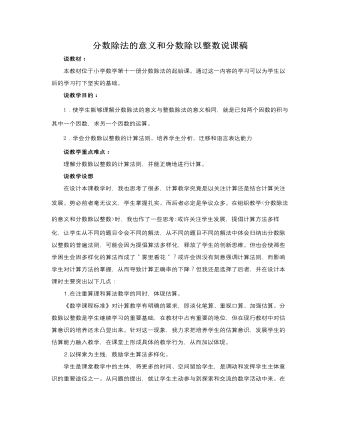
人教版新课标小学数学六年级上册分数除法的意义和分数除以整数说课稿
师:这是一种较为简便、应用广泛的方法,但有时候也要具体问题具体分析,做题时要合理灵活地选择计算方法。《研究学生如何学比研究教师如何教更重要。学生对新知识的学习必须以已有的知识和学习经验作为基础,因此正确分析学生的知识基础和学习经验就显得格外重要。我认为分数除以整数的教学基础在于以下几点:分数与小数的转化;分数的意义;分数乘法的意义;倒数的知识;商不变的性质等。这些知识在以前的学习中,学都有了足够的掌握。有了上面的分析基础,我觉得把研究新知识的权力教给学生,是完全可以的。》4、质疑与反思。师:对于这些方法,尽管大家的思维角度不尽相同,但是基本的想法是相同的,想一想我们是怎样解决问题的?生:用学过的倒数、商不变的性质解决的。师:对。用一句话概括就是运用旧知识解决新新问题。这是一种很重要的学习方法。5、实践体验练习巩固。
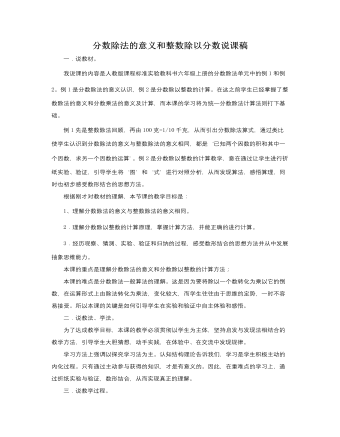
人教版新课标小学数学六年级上册分数除法的意义和整数除以分数说课稿
一.说教材。我说课的内容是人教版课程标准实验教科书六年级上册的分数除法单元中的例1和例2。例1是分数除法的意义认识,例2是分数除以整数的计算。在这之前学生已经掌握了整数除法的意义和分数乘法的意义及计算,而本课的学习将为统一分数除法计算法则打下基础。例1先是整数除法回顾,再由100克=1/10千克,从而引出分数除法算式,通过类比使学生认识到分数除法的意义与整数除法的意义相同,都是‘已知两个因数的积和其中一个因数,求另一个因数的运算’。例2是分数除以整数的计算教学,意在通过让学生进行折纸实验、验证,引导学生将‘图’和‘式’进行对照分析,从而发现算法,感悟算理,同时也初步感受数形结合的思想方法。根据刚才对教材的理解,本节课的教学目标是:1、理解分数除法的意义与整数除法的意义相同。2.理解分数除以整数的计算原理,掌握计算方法,并能正确的进行计算。
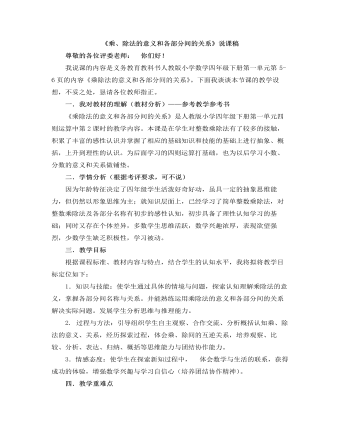
小学数学人教版四年级下册《乘、除法的意义和各部分间的关系》说课稿
尊敬的各位评委老师: 你们好!我说课的内容是义务教育教科书人教版小学数学四年级下册第一单元第5-6页的内容《乘除法的意义和各部分间的关系》。下面我谈谈本节课的教学设想,不妥之处,恳请各位教师指正。一.我对教材的理解(教材分析)——参考教学参考书《乘除法的意义和各部分间的关系》是人教版小学四年级下册第一单元四则运算中第2课时的教学内容。本课是在学生对整数乘除法有了较多的接触,积累了丰富的感性认识并掌握了相应的基础知识和技能的基础上进行抽象、概括,上升到理性的认识。为后面学习的四则运算打基础,也为以后学习小数、分数的意义和关系做铺垫。二.学情分析(根据考评要求,可不说)因为年龄特征决定了四年级学生活泼好奇好动,虽具一定的抽象思维能力,但仍然以形象思维为主;就知识层面上,已经学习了简单整数乘除法,对整数乘除法及各部分名称有初步的感性认知,初步具备了理性认知学习的基础;同时又存在个体差异,多数学生思维活跃,数学兴趣浓厚,表现欲望强烈,少数学生缺乏积极性,学习被动。
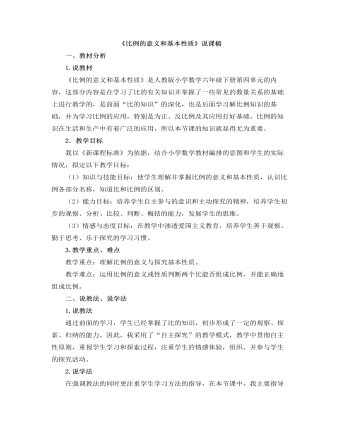
小学数学人教版六年级下册《比例的意义和基本性质》说课稿
1.说教材《比例的意义和基本性质》是人教版小学数学六年级下册第四单元的内容,这部分内容是在学习了比的有关知识并掌握了一些常见的数量关系的基础上进行教学的,是前面“比的知识”的深化,也是后面学习解比例知识的基础,并为学习比例的应用,特别是为正、反比例及其应用打好基础。比例的知识在生活和生产中有着广泛的应用,所以本节课的知识就显得尤为重要。2.教学目标我以《新课程标准》为依据,结合小学数学教材编排的意图和学生的实际情况,拟定以下教学目标:(1)知识与技能目标:使学生理解并掌握比例的意义和基本性质,认识比例各部分名称,知道比和比例的区别。(2)能力目标:培养学生自主参与的意识和主动探究的精神,培养学生初步的观察、分析、比较、判断、概括的能力,发展学生的思维。 (3)情感与态度目标:在教学中渗透爱国主义教育,培养学生善于观察、勤于思考、乐于探究的学习习惯。3.教学重点、难点教学重点:理解比例的意义与探究基本性质。教学难点:运用比例的意义或性质判断两个比能否组成比例,并能正确地组成比例。
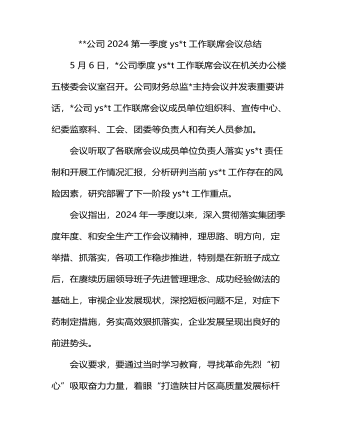
公司2024第一季度意识形态工作联席会议总结
一是要把好正确导向。严格落实主体责任,逐条逐项细化任务,层层传导压力。要抓实思想引领,把理论学习贯穿始终,全身心投入主题教育当中;把理论学习、调查研究、推动发展、检视整改等有机融合、一体推进;坚持学思用贯通、知信行统一,努力在以学铸魂、以学增智、以学正风、以学促干方面取得实实在在的成效。更加深刻领会到******主义思想的科学体系、核心要义、实践要求,进一步坚定了理想信念,锤炼了政治品格,增强了工作本领,要自觉运用的创新理论研究新情况、解决新问题,为西北矿业高质量发展作出贡献。二是要加强应急处事能力。认真组织开展好各类理论宣讲和文化活动,发挥好基层ys*t阵地作用,加强分析预警和应对处置能力,提高发现力、研判力、处置力,起到稳定和引导作用。要坚决唱响主旋律,为“打造陕甘片区高质量发展标杆矿井”、建设“七个一流”能源集团和“精优智特”新淄矿营造良好的舆论氛围。三是加强舆情的搜集及应对。加强职工群众热点问题的舆论引导,做好舆情的收集、分析和研判,把握时、度、效,重视网上和网下舆情应对。
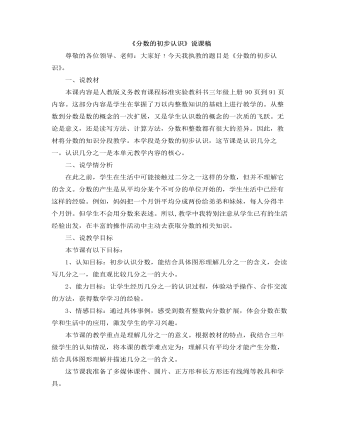
小学数学人教版三年级上册《分数的初步认识》说课稿
一、说教材本课内容是人教版义务教育课程标准实验教科书三年级上册90页到91页内容。这部分内容是学生在掌握了万以内整数知识的基础上进行教学的。从整数到分数是数的概念的一次扩展,又是学生认识数的概念的一次质的飞跃。无论是意义,还是读写方法、计算方法,分数和整数都有很大的差异。因此,教材将分数的知识分段教学。本学段是分数的初步认识,这节课是认识几分之一。认识几分之一是本单元教学内容的核心。二、说学情分析在此之前,学生在生活中可能接触过二分之一这样的分数,但并不理解它的含义。分数的产生是从平均分某个不可分的单位开始的,学生生活中已经有这样的经验。例如,妈妈把一个月饼平均分成两份给弟弟和妹妹,每人分得半个月饼。但学生不会用分数来表述。所以,教学中我特别注意从学生已有的生活经验出发,在丰富的操作活动中主动去获取分数的相关知识。
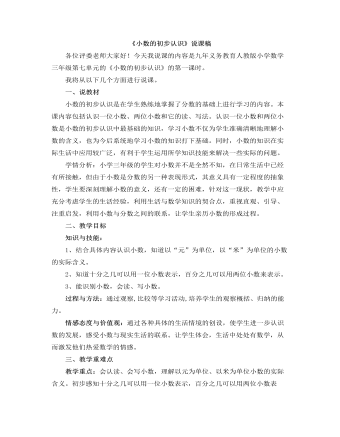
小学数学人教版三年级下册《小数的初步认识》说课稿
一、说教材小数的初步认识是在学生熟练地掌握了分数的基础上进行学习的内容。本课内容包括认识一位小数、两位小数和它的读、写法。认识一位小数和两位小数是小数的初步认识中最基础的知识,学习小数不仅为学生准确清晰地理解小数的含义,也为今后系统地学习小数的知识打下基础。同时,小数的知识在实际生活中应用较广泛,有利于学生运用所学知识技能来解决一些实际的问题。学情分析:小学三年级的学生对小数并不是全然不知,在日常生活中已经有所接触,但由于小数是分数的另一种表现形式,其意义具有一定程度的抽象性,学生要深刻理解小数的意义,还有一定的困难,针对这一现状,教学中应充分考虑学生的生活经验,利用生活与数学知识的契合点,重视直观、引导、注重启发,利用小数与分数之间的联系,让学生亲历小数的形成过程。
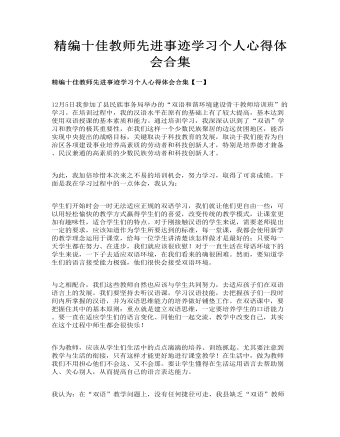
精编十佳教师先进事迹学习个人心得体会合集
学生们开始时会一时无法适应正规的双语学习,我们就让他们更自由一些:可以用轻松愉快的教学方式赢得学生们的喜爱,改变传统的教学模式,让课堂更加有趣味性,适合学生们的特点。对于刚接触汉语的学生来说,需要老师提出一定的要求,应该知道作为学生所要达到的标准,每一堂课,我都会使用新学的教学理念运用于课堂,给每一位学生讲清楚该怎样做才是最好的;只要每一天学生都在努力、在进步,我们就应该很欣慰!对于一直生活在母语环境下的学生来说,一下子去适应双语环境,在我们看来的确很困难。然而,要知道学生们的语言接受能力极强,他们很快会接受双语环境。
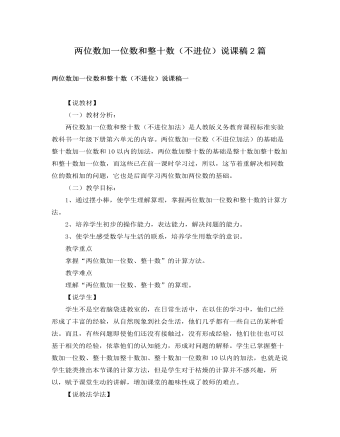
人教版新课标小学数学一年级下册两位数加一位数和整十数(不进位)说课稿2篇
(二)创设情境,探索新知。1、创设情境,激发兴趣。小白兔和小熊要坐公交车去公园,他们来到公交公司,先后看到公交公司有一边说一边课件出示课件,请同学们仔细观察,把你从图上看到的物品和读出的数据告诉老师和其他同学。你能根据这些信息提出不同的数学问题吗?再从同学们提出的众多问题中选择两个具有代表性的问题来列式和计算。课件出示主题图下列两个问题:指名说出两个问题的算式分别是什么,明确45 + 30和45 + 3是两位数加一位数和两位数加整十数的加法算式,引出课题——两位数加一位数和整十数(不进位)这一层次从学生熟悉的生活情境出发,选择学生熟悉的旅游,让学生自己发现、提出有关的数学问题,从而主动的解决问题。这里通过创造出生动的生活情境来提取例题,符合学生的年龄、认知特征,既激发了学生的学习兴趣,又使学生感受到数学与生活的密切联系,容易为学生所感知,所接受。
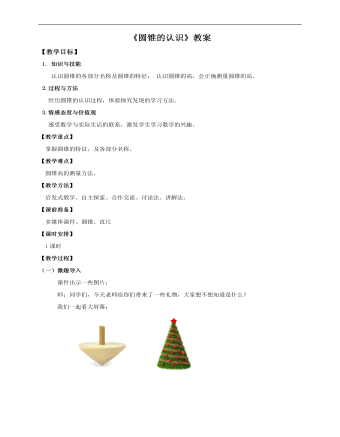
小学数学人教版六年级下册《第四课圆锥的认识》教案说课稿
2.过程与方法 经历圆锥的认识过程,体验探究发现的学习方法。3.情感态度与价值观 感受数学与实际生活的联系,激发学生学习数学的兴趣。【教学重点】 掌握圆锥的特征,及各部分名称。【教学难点】圆锥高的测量方法。【教学方法】启发式教学、自主探索、合作交流、讨论法、讲解法。【课前准备】多媒体课件、圆锥、直尺
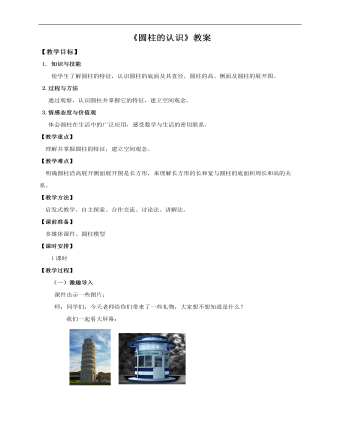
小学数学人教版六年级下册《第一课圆柱的认识》教案说课稿
(一)激趣导入 课件出示一些图片:师:同学们,今天老师给你们带来了一些礼物,大家想不想知道是什么?我们一起看大屏幕:你们认识这些物体吗?在生活中见到过吗?生:比萨斜塔、治安岗亭、茶叶盒、客家围屋。师:今天这节课我们重点来研究这些物体。(二)探究新知 1. 认识圆柱。师:这些物体什么形状的?它们的形状有什么共同特点?生:这些物体都是圆柱形的。师小结:这些物体的形状都是圆柱体,简称圆柱。说一说生活中有哪些圆柱形的物体。2.探究圆柱的特特征。(1)认识底面小组活动: 观察圆柱形物体,看看它是有几部分组成的,有什么特征?课件演示:圆柱的上、下两个面叫做底面,是两个完全相同的圆。 师:请同学们量一量、算一算圆柱的两个底面有什么关系?生1:两个底面的直径相等、半径相等。生2:两个底面的周长相等、面积相等。师小结:圆柱的底面是两个完全相同的圆。(2)认识侧面课件演示:圆柱周围的面叫做侧面,侧面是一个曲面。师:请同学们指一指圆柱的侧面,再用手摸一摸,有什么感觉?生:侧面是弯曲的。师:侧面是一个曲面。

新人教版高中英语选修2Unit 3 Learning about Language教学设计
1. We'll need ten months at least to have the restaurant decorated.2.Some traditional Chinese dishes from before the Ming Dynasty are still popular today.3.My grandpa's breakfast mainly includes whole grain biscuits and a glass of milk.4.People in this area would eat nearly a kilo of cheese per week.5. We enjoyed a special dinner in a fancy restaurant where the waiters all wore attractive suits.6. He prefers this brand of coffee which, as he said, has an unusually good flavor.Key:1. at a minimum 2. prior to3. consist of4. consume5. elegant6. exceptionalStep 5:Familiarize yourself with some food idioms by matching the meaning on the right with the colored words on the left.1.Public concern for the health of farm animals has mushroomed in the UK2.Anderson may be young but he's certainly rolling to doing dough!3.George is a popular lecturer. He often peppers his speech with jokes.4.As the person to bring home the bacon, he needs to find a stable job.5 He is often regarded as a ham actor for his over emphasized facial expressions. The media reported that these companies had treated pollution as a hot potato. 6.The media reported that these companies had treated pollution as a hot potato.7.Don't worry about the test tomorrow. It's going to be a piece of cake!8. It's best to fold the swimming ring when it is as flat as a pancake.A. completely flatB. something that is very easy to do C.an issue that is hard to deal withD.to include large numbers of somethingE.to earn on e's living to support a familyF. wealthyG.to rapidly increase in numberH. an actor who performs badly, especially by over emphasizing emotions

新人教版高中英语选修2Unit 2 Learning about Language教学设计
The activity theme of this section is to design various activities around the key words in the first text. Therefore, the activities require students to pay attention to the spelling of words. On the other hand, let students grasp the meaning of words more accurately through sentences and short texts. This kind of teaching design also helps to improve the ability of using English thinking.1. Cultivating students' ability to use word formation to induce and memorize vocabulary, and the ability to use lexical chunks to express meaning.2. Guide the students to think independently and use the correct form of words to complete sentences3. Cultivate students' habit of using lexical chunks to express language completely, guide students to draw words in sentences quickly, pay attention to word collocation, so as to accumulate more authentic expressions4. Instruct students to create sentences with the chunks.1. Enable students to use the language points in the real situation or specific contexts flexibly and appropriately.2. Guiding the Ss to use unit topic words and the sentence patterns in a richer context.Step1: Think of a word that best fits each definition.1. to remember sth2.to accept, admit, or recognize sth or the truth/existence of sth3. the process of changing sth or yourself to suit a new situation4 .to make sb feel less worried or unhappy5. a strong desire to achieve sth

新人教版高中英语选修2Unit 3 Reading for writing教学设计
The theme of this part is to write an article about healthy diet. Through reading and writing activities, students can accumulate knowledge about healthy diet, deepen their understanding of the theme of healthy diet, and reflect on their own eating habits. This text describes the basic principles of healthy diet. The author uses data analysis, definition, comparison, examples and other methods. It also provides a demonstration of the use of conjunctions, which provides important information reference for students to complete the next collaborative task, writing skills, vivid language materials and expressions.1. Teach Ss to learn and skillfully use the new words learned from the text.2. Develop students’ ability to understand, extract and summarize information.3. Guide students to understand the theme of healthy diet and reflect on their own eating habits.4. To guide students to analyze and understand the reading discourse from the aspects of theme content, writing structure, language expression, etc., 5. Enable Ss to write in combination with relevant topics and opinions, and to talk about their eating habits.1. Guide students to analyze and understand the reading discourse from the aspects of theme content, writing structure, language expression, etc.2. Enable them to write in combination with relevant topics and opinions, and to talk about their eating habits.3. Guide the students to use the cohesive words correctly, strengthen the textual cohesion, and make the expression fluent and the thinking clear.Step1: Warming upbrainstorm some healthy eating habits.1.Eat slowly.2.Don’t eat too much fat or sugar.3.Eat healthy food.4.Have a balanced diet.Step2: Read the passage and then sum up the main idea of each paragraph.

新人教版高中英语选修2Unit 2 Reading for writing教学设计
The theme of this section is to express people's views on studying abroad. With the continuous development of Chinese economic construction, especially the general improvement of people's living standards, the number of Chinese students studying abroad at their own expense is on the rise. Many students and parents turn their attention to the world and regard studying abroad as an effective way to improve their quality, broaden their horizons and master the world's advanced scientific knowledge, which is very important for the fever of going abroad. Studying abroad is also an important decision made by a family for their children. Therefore, it is of great social significance to discuss this issue. The theme of this section is the column discussion in the newspaper: the advantages and disadvantages of studying abroad. The discourse is about two parents' contribution letters on this issue. They respectively express their own positions. One thinks that the disadvantages outweigh the advantages, and the other thinks that the advantages outweigh the disadvantages. The two parents' arguments are well founded and logical. It is worth noting that the two authors do not express their views on studying abroad from an individual point of view, but from a national or even global point of view. These two articles have the characteristics of both letters and argumentative essays1.Guide the students to read these two articles, and understand the author's point of view and argument ideas2.Help the students to summarize the structure and writing methods of argumentative writing, and guides students to correctly understand the advantages and disadvantages of studying abroad3.Cultivate students' ability to analyze problems objectively, comprehensively and deeply

新人教版高中英语选修2Unit 5 Using langauge-Listening教学设计
The theme of this section is to learn how to make emergency calls. Students should learn how to make emergency calls not only in China, but also in foreign countries in English, so that they can be prepared for future situations outside the home.The emergency telephone number is a vital hotline, which should be the most clear, rapid and effective communication with the acute operator.This section helps students to understand the emergency calls in some countries and the precautions for making emergency calls. Through the study of this section, students can accumulate common expressions and sentence patterns in this context. 1.Help students accumulate emergency telephone numbers in different countries and learn more about first aid2.Guide the students to understand the contents and instructions of the telephone, grasp the characteristics of the emergency telephone and the requirements of the emergency telephone.3.Guide students to understand the first aid instructions of the operators.4.Enable Ss to make simulated emergency calls with their partners in the language they have learned1. Instruct students to grasp the key information and important details of the dialogue.2. Instruct students to conduct a similar talk on the relevant topic.Step1:Look and discuss:Match the pictures below to the medical emergencies, and then discuss the questions in groups.


